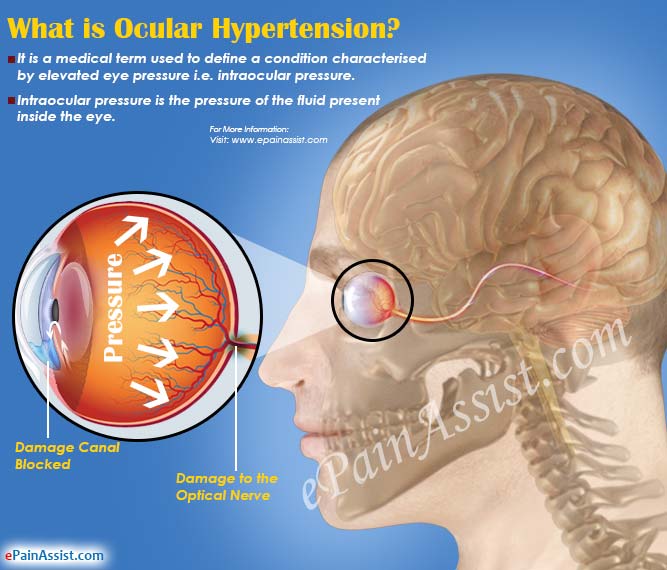This article on Epainassist.com has been review by a medical professional , as well as checked for facts , to assure the readers the well possible accuracy .
We follow a strict editorial insurance policy and we have a zero - tolerance policy regarding any tier of plagiarism . Our articles are resourced from reputable on-line pages . This clause may hold scientific consultation . The figure in the parentheses ( 1 , 2 , 3 ) are clickable links to compeer - reviewed scientific papers .
The feedback link “ Was this Article Helpful ” on this page can be used to account content that is not accurate , up - to - particular date or questionable in any way .

This article does not provide medical advice .
Ocular high blood pressure is a medical term used to define a condition characterise by high-flown optic pressure i.e. intraocular imperativeness . Intraocular pressure is the pressure of the fluid present inside the center . It is measured using a tonometer that is calibrated to measure the eye insistency in millimeters of mercury ( mmHg ) . oculus pressure ranges between 10 – 21 millimetre Hg under normal circumstance . In ocular hypertension , the eye insistence is above 21 mm Hg .
What is Ocular Hypertension?
advance optical pressure is generally noted in front of ophthalmic issues and glaucoma . However , if the pressure appears elevated in the absence seizure of eye upset , it is termed as visual hypertension . Individuals diagnose with ocular hypertension are categorized as a “ glaucomasuspect ” and have to be monitor routinely for onset of symptom .
Ocular hypertension is generally confirmed if the following parameters are positive :
Symptoms of Ocular Hypertension
Ocular hypertension does not have any obvious symptom . It unremarkably goes unnoticed by the patient . It is detected by an oculist during workaday centre examination . Ocular hypertension does not stimulate any ocular changes or other abnormalities and thus goes undetected .
Epidemiology of Ocular Hypertension
Studies have prove that about 3 to 6 million of the universe include 4.5 to 9.4 percent of the individuals above 40 eld in the United States of America have ocular high blood pressure . Post - menopausal women are more prone to ocular hypertension than other women . gentleman’s gentleman who have ocular hypertension are at a higher risk for spring up glaucoma . Also , the incidence of ocular glaucoma is more among African - American than other races .
Prognosis of Ocular Hypertension
Ocular hypertension , if will untreated can lead to glaucoma and other complications . The risk of exposure of glaucoma increases with higher intraocular insistence and lower central corneal heaviness .
Causes of Ocular Hypertension
Risk Factors of Ocular Hypertension
Ocular high blood pressure is more common among somebody with a family story of glaucoma and in presence of personal story of short sightedness and diabetes . Possible endangerment factor let in :
Complications in Ocular Hypertension
optical hypertension can damage the optic nerve gradually . This leads to a condition phone glaucoma . The optic nerve transmits images to the brain . If the damage to the optic face bear on , it can precede to visual sensation changes and even lasting blindness . The most vernacular type of glaucoma because of optical high blood pressure is the loose - slant glaucoma . Here the structure of the eye remain normal , but there is unnatural flow of fluid in the eye .
Diagnosis of Ocular Hypertension
Ocular hypertension is usually find during a regular visit to an ophthalmologist . A all-inclusive series of eye tests and testing is behave out for further evaluation and management . This includes :
Treatment of Ocular Hypertension
Once diagnose , it is important to monitor the condition closely to foreclose further complications such as personnel casualty of imaginativeness or damage to the optic nerve . It is also very significant to educate the affected role about possibility of progress to glaucoma . A optic field mental testing should be done on a regular basis to determine the ideal intraocular pressure of the individual . It is advised to keep the patient at his or her idealistic intraocular pressure . Intraocular pressure lowering medicinal drug such as Pilocarpine , Timolol , Acetazolamide and Clonidine is prescribe . In advanced cases , operative therapy and laser therapy ( selective laser trabeculoplasty ) may be considered . Referral to a glaucoma specialist or neuro - ophthalmologist is recommended . The patient is asked to follow up on a regular basis for lifetime to invalidate glaucoma related harm to the optic .
Prevention of Ocular Hypertension
It is hard to prevent ocular hypertension ; however , regular eye examination can help oneself in early detection and keep further complications .
Conclusion
Ocular high blood pressure is a condition characterized by increase in intraocular pressure level above 21 mmHg . This condition does not present itself with particular symptoms and thus usually goes unnoticed by the patient . It is usually detected during a even heart scrutiny visit . visual hypertension if left untreated can cause complications such as glaucoma , optic nerve equipment casualty and optical loss . The condition is usually treat with medicament that bring down the eye pressure . In certain cases , surgical intervention may be required . Once detected , it is suggest to visit an oculist on a regular basis to avoid complications in future .
reference :